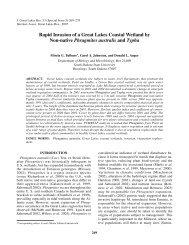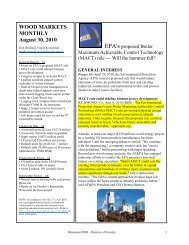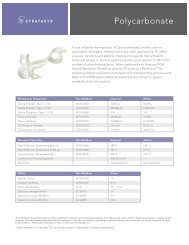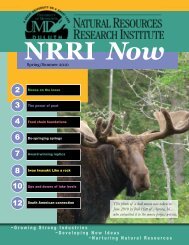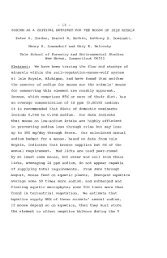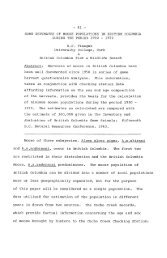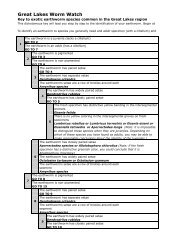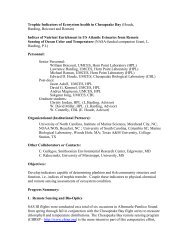Canada Lynx in the Great Lakes Region - Minnesota Department of ...
Canada Lynx in the Great Lakes Region - Minnesota Department of ...
Canada Lynx in the Great Lakes Region - Minnesota Department of ...
You also want an ePaper? Increase the reach of your titles
YUMPU automatically turns print PDFs into web optimized ePapers that Google loves.
<strong>Canada</strong> <strong>Lynx</strong> <strong>in</strong> <strong>the</strong> <strong>Great</strong> <strong>Lakes</strong> <strong>Region</strong> 2005 Annual ReportExecutive SummaryWe summarize <strong>the</strong> third year <strong>of</strong> a project on <strong>Canada</strong> lynx ecology <strong>in</strong> <strong>the</strong> <strong>Great</strong> <strong>Lakes</strong> region.The project is designed to address four major questions about this population <strong>of</strong> <strong>Canada</strong> lynx:distribution, habitat use, abundance, and persistence. In <strong>the</strong> first 33 months <strong>of</strong> this project wecaptured and deployed radiotelemetry collars on 32 <strong>Canada</strong> lynx. Each animal was locatedapproximately biweekly after be<strong>in</strong>g collared when logistically feasible.GPS collars have been deployed on 12 <strong>of</strong> <strong>the</strong> lynx <strong>in</strong> this project. Over 12,000 locations wereobta<strong>in</strong>ed from GPS collars at <strong>the</strong> end <strong>of</strong> 2005. GPS collar locations will be fundamental tounderstand<strong>in</strong>g movements and habitat use <strong>of</strong> <strong>Canada</strong> lynx. Ambient temperature and animal activitylevel is recorded by <strong>the</strong> collars <strong>in</strong>dicat<strong>in</strong>g daily patterns <strong>in</strong> activity, and also shows how active ananimal was when each GPS location was obta<strong>in</strong>ed.Radiocollared females have had kittens <strong>in</strong> 2004 and 2005, and at least 5 <strong>of</strong> <strong>the</strong> 12 kittensknown from den visits <strong>in</strong> 2005 survived until December 2005. Of <strong>the</strong> 2004 litters, 1 and possibly 2<strong>of</strong> <strong>the</strong> known <strong>of</strong>fspr<strong>in</strong>g were alive at <strong>the</strong> end <strong>of</strong> 2005. Of <strong>the</strong> 32 lynx radiocollared by December 31,2005, 2 died <strong>in</strong> 2003 and no animals were recovered dead <strong>in</strong> 2004. We recorded <strong>the</strong> deaths <strong>of</strong> 14radiocollared animals <strong>in</strong> 2005, one <strong>of</strong> which had died <strong>in</strong> 2004.We f<strong>in</strong>ished <strong>the</strong> third year <strong>of</strong> surveys for snowshoe hare, <strong>the</strong> major prey species <strong>of</strong> <strong>Canada</strong>lynx. Permanent pellet plots were established throughout <strong>the</strong> SNF for snowshoe hare. Plots weredistributed based on stratified random, systematic, and selective site selection strategies. Manystratified random plots had few or no pellets. The highest pellet density over two years <strong>of</strong> pelletsurveys occurred <strong>in</strong> young red p<strong>in</strong>e and young upland black spruce cover types. A mark-recaptureexperiment will make it possible to estimate density <strong>of</strong> snowshoe hares from pellet plots.We cont<strong>in</strong>ue to use <strong>the</strong> project website (www.nrri.umn.edu/lynx) to provide <strong>in</strong>formation tobiologists and <strong>the</strong> general public. The website gets over 1,000 page requests per day. This website isa historical record <strong>of</strong> <strong>the</strong> project, lists project goals and accomplishments, and gives <strong>in</strong>formation andpictures <strong>of</strong> each lynx. The annual reports and o<strong>the</strong>r publications on <strong>the</strong> project are or will be availablefor download. Trail camera images were added to <strong>the</strong> website <strong>in</strong> 2005.We beg<strong>in</strong> <strong>the</strong> report with a brief chronological summary <strong>of</strong> <strong>Canada</strong> <strong>Lynx</strong> ecology <strong>in</strong> <strong>the</strong> <strong>Great</strong><strong>Lakes</strong> region. The project has been supported by several agencies with some common deliverablesand some deliverables that varied among agencies. To produce a cohesive, logically organizedannual report, we describe <strong>the</strong> project <strong>in</strong> its entirety, and we <strong>in</strong>dicate specific deliverables <strong>in</strong>Appendix 1. We first describe <strong>Canada</strong> lynx trapp<strong>in</strong>g and <strong>the</strong> deployment <strong>of</strong> radiotelemetry collars.The radiotelemetry program is very important because each <strong>of</strong> <strong>the</strong> major deliverables depends ontelemetry data. Next, we address progress made on each <strong>of</strong> <strong>the</strong> major questions: 1) distribution, 2)habitat use, 3) abundance, and 4) persistence. Prey species surveys and o<strong>the</strong>r aspects <strong>of</strong> <strong>the</strong> projectare also summarized.We conclude ma<strong>in</strong> sections with <strong>the</strong> current status and future plans for each topic. Some <strong>of</strong><strong>the</strong> questions will require several years <strong>of</strong> data collection which was built <strong>in</strong>to <strong>the</strong> project master plan.With <strong>the</strong> number <strong>of</strong> <strong>Canada</strong> lynx now radiocollared and <strong>the</strong> number <strong>of</strong> locations available, datacollected on this project were used to assist <strong>in</strong> management decisions <strong>in</strong> 2005.ii




